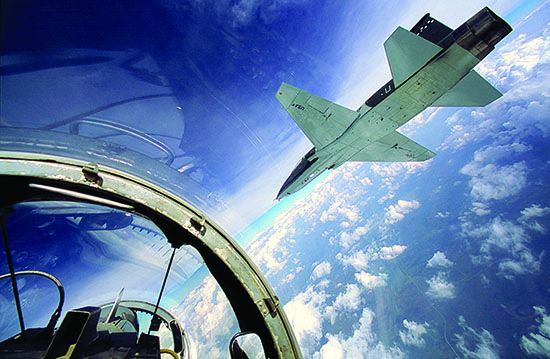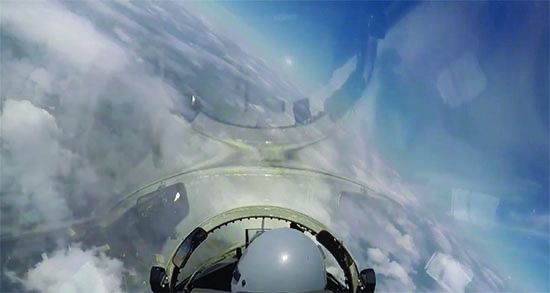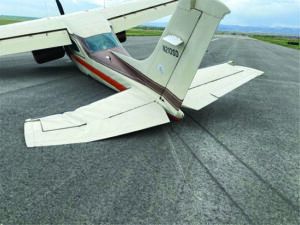
So I’m flying along, fat dumb and happy, into the Charlottesville-Albemarle (Va.) Airport (KCHO). The tower controller tells me to enter a right base for Runway 03, which I do, followed by a touch-and-go and entering left closed traffic like a good boy. I mentally pat myself on the back, and think, “Good job, flying here at a Class D airport with the big boys in your little experimental hot rod.”
The controller then says, “Experimental 12345, you are number two to follow a Cirrus on short final, do you have the traffic in sight?” I say, “Experimental 12345, tally,” and the tower clears me to do a touch-and-go behind him, number two. I roll out on final and see the Cirrus still on the runway, still on the runway—still on the runway, two-thirds of the way down it now. Absolutely hogging the runway.
On short, short final, I see the Cirrus start to slowly angle toward a taxiway, but the aircraft is still very much on the runway, so I push up the power, start a climb, raise the gear and start to fly the go-around. Then I hear a voice say, “You didn’t have to go around.”
I keyed the mic and said, “Say again?” The voice repeated, “You didn’t have to go around.”
I thought it was the pilot in the Cirrus, and I was angry with him for hogging the runway with his billion-foot landing rollout. I snapped back, “What, you wanna come up here and fly this thing for me, too?”
The voice said “No, no, I don’t wanna do that, I’m just saying you didn’t have to go around.”
Then I realized—ack!—it was the tower guy, not the Cirrus guy. So I said, “Oh, this is tower. I’m sorry, I thought it was the guy in the Cirrus! I saw the guy on the runway, and made a decision to go around.”
The tower voice then scolded me like a bad little boy who had gotten caught stealing candy. “That is my call whether to go around. You had plenty of room.”
REAFFIRMATION
For a few seconds, hearing the scolding tone of voice from the tower, I instinctively thought I had done something wrong, that I was maybe in trouble. Like he would tell me to copy a phone number to call when I got on the ground. Then I snapped out of it. A pilot can go around any time they think it’s necessary. The tower can’t make a pilot land if the pilot doesn’t think it’s safe to do so.
I didn’t say anything else to the tower about that, and left the pattern. But it was a reaffirmation that, to quote FAR 91.3, “The pilot in command of an aircraft is directly responsible for, and is the final authority as to, the operation of that aircraft.” And the reg goes on to say that, if you have an emergency, you can deviate from any rule. Whoa, Any rule? Yup.
What if you don’t “declare” an emergency? Doesn’t matter; an emergency is still an emergency, radio call or not. Tell your story later, but you’re cleared to do whatever in an emergency. Of course, the FAA might well want a really good explanation of your “emergency,” and why you had to, uhhh, fly under that bridge. But I digressify.

There you are, stuck on top of an overcast. You’ve got gas, so there’s only a little urgency. The terrain underneath is mostly flat, with good VFR reported underneath. If you can only get down. Then you spot a hole in the undercast, and you can see the ground at the bottom. Is this a “sucker hole,” which you’ll regret entering, or the answer to your dilemma? It depends.

The problem, of course, is the hole may go all the way to the ground. Climbing back out of a sucker hole, once its true identify has been revealed, is more taxing than the descent, and the whole maneuver can be a waste of time and fuel. It also can be risky, since you don’t know whether or when the hole you’re planning to use might close up.
Sucker holes are a particular threat to VFR-only pilots who find themselves on top of a cloud deck with no way to get down. Turns out your adventure won’t be the first time anyone’s gotten stuck on top. The Bullet points at lower right may help. — J.B.
FORMATION FRUSTRATION
I was in the U.S. Air Force, and as a T-38 instructor pilot (IP), we had to train students in all phases of flight. Contact, which is VFR, plus IFR—the student in the back seat “under the bag,” low-level at 400 knots or so, and formation flying. Sometimes the formation flying got sporty, flying around at 300-600 knots. “Wingwork,” which is where you fly three feet off your “lead” aircraft, had two restrictions: No sudden turn reversals; no more than 3Gs. So you could fly big Lazy 8s, at 550 knots for example, or pull 3Gs and go 40 degrees nose-high. Heh heh heh.
I was out with a student aboard my aircraft, with a solo student in formation on my wing, when clouds started to roll into Laughlin Air Force Base. No more flying along fat, dumb and happy, having fun in formation—we gotta get back and get down and land before that overcast covers the base. I took “lead” with the solo student on my wing, and back we went, “hauling the mail.” I was concerned—we only have so much fuel in the T-38 and the clouds were rolling in.
When I called the military ATC folks for a lower altitude, to get under the clouds on the way in, they told me to stand by. So we flew along toward Laughlin at about 350 knots at 14,000 feet. Up ahead, I could see only one hole in the clouds, right in front of us. One hole, that was it—the rest of the undercast looked like the polar ice cap. The hole was fairly large—I could see the ground—and I figured we could circle down in that hole and get below the overcast. I asked for lower altitude again. Again ATC said, “Stand by,” but gave no reason. I couldn’t hear or see any traffic conflicts.

It was a VFR day, and many of us T-38s were out in the MOA doing maneuvers. But the clouds rolled in quickly—again—and suddenly the entire base had an overcast at 1500 feet. One by one, the T-38s returned to base, but everybody had to do a straight-in instrument approaches to the center runway. There were maybe 12 airplanes airborne and by the time everybody is stacked back behind each other on the long straight in, they were getting low on fuel. Including me. At 800 pounds remaining, you have to declare “minimum fuel.” So as soon as I hit 800 pounds of fuel remaining, I keyed the mic and reported minimum fuel.
That was it, the dam broke. The radio dam. Suddenly there was another call, and another. And another. You get the idea. Then a tense voice came on the radio, saying, “Emergency fuel.” Four hundred pounds remaining.
The pilot had waited and waited, hoping he could land without sounding bad on the radio. He got priority, and was vectored to a landing ahead of everyone else.
Which is why we exercise our PIC authority, and do what we have to do to be safe, in this case tell the world you’re short on fuel. Like “emergency short.”
ASSERTIVENESS PAYS OFF
Now we’re approaching that hole in the clouds and if we don’t get cleared lower we’re going to overfly it. I slow down slightly and asked again for lower, and again ATC said, “Stand by.” I couldn’t stand by any longer. I said, “Are you going to give us lower or what!!?” That got his attention, and a “my-feelings-are-hurt” voice came back on the radio: “Cleared to 7000 feet.”
I made the “boards out” hand motion to my solo wingman, and we both dropped the belly-mounted speed brakes and flew down into that big hole in the cloud deck in a 30-to-45-degree banked spiraling turn. Down, down we went from 14,000 feet, and the white clouds were all around us, like being in the eye of a hurricane. I glanced over at the solo student—he was right there on my wing, three feet away, glued to me, Johnny-on-the spot, good boy. He thought it was great, he said later. And it was cool, all white around us like that. We spiraled down—and poof!—we were below the deck. Up came the speed brakes, and we landed uneventfully from the overhead pattern.
After we landed, there was a note by my name on the aircraft sign-in board: “See SOF.” The supervisor of flying. Shucks. That’s never good. But I didn’t know why. I walked over and said, “Hello sir, I got a note to see you?” Older pilot, really good guy; I had flown with him before as a new instructor pilot. He said, “We spent a lot of time building a relationship with ATC, getting to know them and get along with them….”
I broke in and said sternly, “Sir, I had a solo on the wing, and I had to get down through that hole, the only hole in the clouds, or we would have had to divert. ATC kept telling me to stand by, stand by, but there was no traffic in the way, no conflict—he just wouldn’t give me lower.” The SOF nodded his head. He understood—I was right. I did what I had to do.
FAST FORWARD
So here at my home airport 30 years later, I’m a mere civilian with wretched Class Bravo airspace over the airstrip. This isn’t uncommon, but when it’s your home airport, you kinda wish the altitude shelves weren’t there. First, stay below 1500, then 2500, and then 4500, until the canary is free from the overhead net, but wait—there’s more to the distraction of step-up or step-down altitudes. All canaries—I mean aircraft—on VFR flights must stay below the Class B altitudes, and all those aircraft come and go in the same small “corridor” to the airport. So we’re all at the roughly the same altitude and the same general area.
Now our tower can see us on radar. Does it help? Sometimes. I was cleared for “the option, number two, behind the Archer on final” the other day. My aircraft is much faster than an Archer, but I knew that, and I slowed down as much as possible, to about 100-105 knots on final. My aircraft, if stalled, will snap-stall, and the wing will drop 70 degrees with no warning. So flying near the full-flaps stall speed of 72 knots would be, in technical terms, nutso. So I’m on final, 100 knots or so, starting to eat this guy up.
He lands, takes his time doing a touch-and-go, fair enough, and I’m still cleared to land behind him. He just gets airborne before I landed, and on my touch-and-go, he’s hanging up there in front of me like a kite, going slow-mo, like an Archer does, and tower is silent. I rotate at 85 knots, accelerate, climb out at 110 and I am eating him up. I request right traffic, which is approved.
Why didn’t the tower see me gaining on the aircraft ahead? Why didn’t the tower tell one of us to go right, one go left? There were two planes in the pattern, so it’s not like the tower was task-saturated. My point? I’m the one who has to think, and to use my PIC authority. I can’t 100-percent rely on the tower for separation in the pattern. No way. It’s my fault if I get too close to that guy, really, not the tower’s. I have to sit up, pay attention and not let the tower kill me.

I was out visiting a nearby airport the other day, arriving right after another plane had some difficulty and suffered some damage, ending up on a taxiway, just off the runway. But I didn’t know any of this at the time. I called an eight-mile straight-in for the runway and a woman’s voice came on the non-towered facility’s CTAF, saying, “The airport is closed.” That was all.
I continued my RNAV approach, did a low approach and saw the crippled airplane just off the runway. At least 4000 of the 5000 feet was clear of any visible FOD. Nevertheless, I started to fly away. Then I heard a Diamond pilot say, “Uhh, we got a rough-running engine and we need to get this thing on the ground. I need a runway.” The woman’s voice again said, “The runway is closed.” Then another pilot’s voice came on the radio: “Declare an emergency.” The Diamond pilot came back on the radio. He said “Uhh, we’re feeling better about the engine now; we’ll depart.”
To me, this was another example of a pilot not really realizing that he was the authority, not the lady on the ground, drinking coffee in the FBO with a microphone. Nope, the pilot.
THE FLIP SIDE
Oh, you think I’m kidding? Don’t get me wrong—the tower, or ATC can be very helpful. Before our tower got radar, it was buyer-beware, see-and-avoid, because the controllers couldn’t see us on radar. It could get downright sporty, with tower telling you to enter downwind and there’s one or four planes in the pattern that might be right in the way—like someone turning crosswind, someone ahead but slower, someone on opposite downwind, someone on opposite base. You get the idea.
A pilot had to use their aeronautical decision-making to avoid conflicts. But even then a number of pilots relied on the tower for separation. Like the time I had to go around and make left traffic. There was a guy on left downwind doing a 360 for spacing, which tower told him to do. The tower basically flew me right into him, almost. I learned a lesson from that NMAC scare: I am responsible for not hitting someone. Me, the pilot. Not the tower.
For another example, I was flying into Henderson Field, KHND, outside Las Vegas. You catch an Uber and you’re on the Strip and at a craps table in 20 minutes, betting on a sure number. (Twenty minutes after that, you’re at the ATM and looking for a nearby pawnshop. But I digress again.)
The Henderson tower controller cleared me to fly a left downwind to Runway 17L. I entered the left downwind on a 45-to-downwind, and was just past the numbers of the approach when the tower told me to make my base turn now to avoid the Class Bravo airspace. I left turned immediately, thank you KHND tower guys.
There’s only about 1.3 miles from the approach end numbers of 17L to the Class B airspace. Who knew? ForeFlight did, actually, and I dorked it up. But the tower saved me. That time.
Matt Johnson is former U.S. Air Force T-38 instructor pilot and KC-135Q copilot. He’s now a Virginia-based flight instructor.




91.113 (f) Overtaking. Each aircraft that is being overtaken has the right-of-way and each pilot of an overtaking aircraft shall alter course to the right to pass well clear.
I believe this covers your pattern climb overtake?